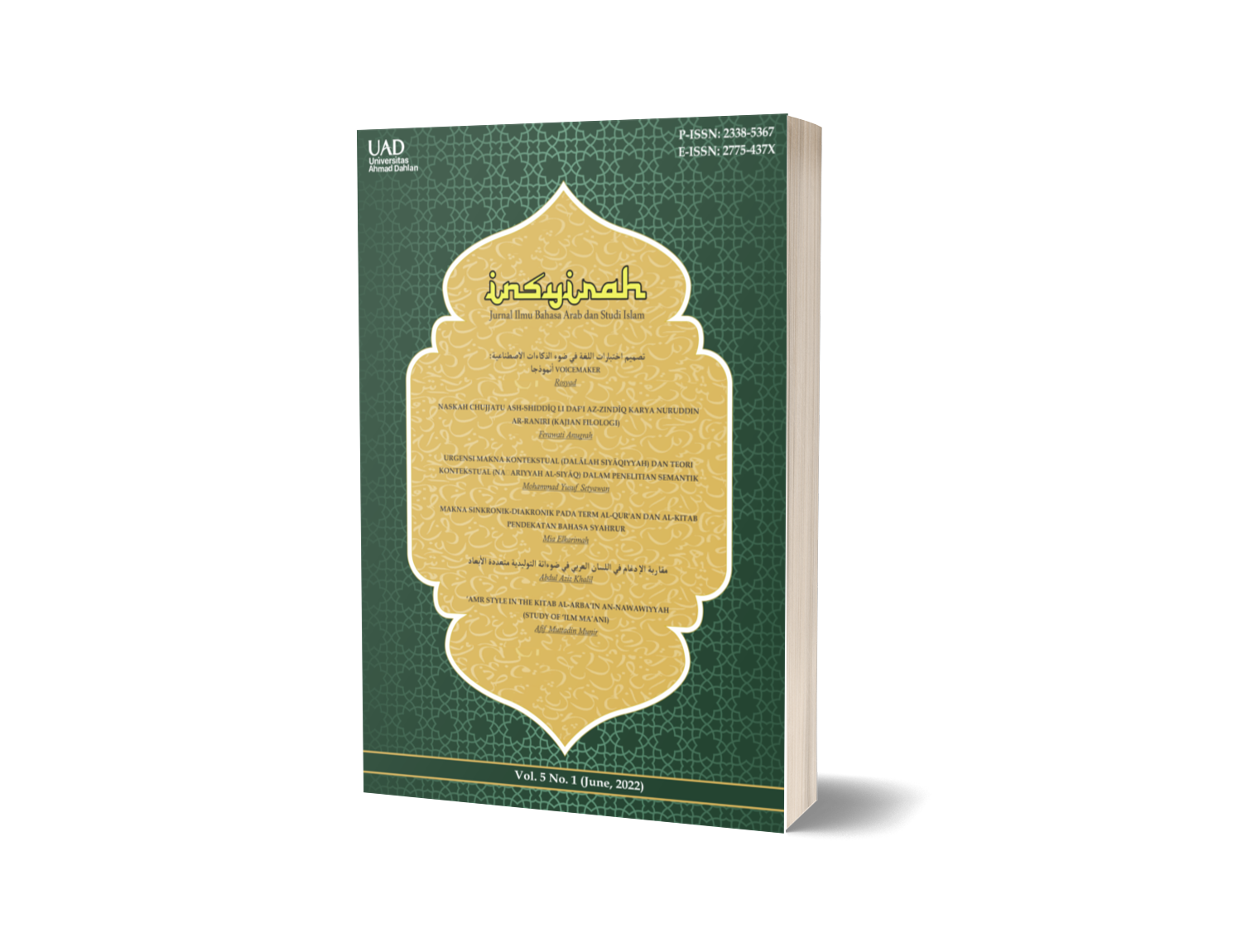Transformational-Generative in Class X Senior High Shcool Arabic Book
DOI:
https://doi.org/10.26555/insyirah.v6i1.8095Keywords:
Tranformational-Generative, Textbook, Noam ChomskyAbstract
There are several cases that occur in Class X, namely: 1) many students do not understand grammar because of the lack of explanation in detail and detail presented in the learning Book, 2) because the lack of presentation of grammar in the textbook reduces the value of the quantity of the textbook. The method used in this study is a literature study, using qualitative descriptive method. The research Data consisted of four aspects, namely book Language, Language skills, vocabulary learning, and sharaf learning aspects. The source of the data in the form of Arabic textbook entitled Arabic student book Scientific Approach curriculum 2013 X Madrasah Aliyah and works sourced from articles about transformative generative theory with data in the form of analysis based on the text read in the book. The purpose of this study was to analyze the Arabic book Madrasah Aliyah Class X with the approach of generative theory Transformative Noam Chomsky. The results showed that class X Arabic textbooks viewed from the view of Noam Chomsky lack of entry in the language order because the arrangement in the textbook has not paid much attention to the side of the language order, so that students ' understanding of the words/sentences presented are still poorly understood. So, it is necessary to add a more detailed and detailed explanation of the grammatical structure that will make it easier for students to learn Arabic well.
References
Al-Dîn, M. J. (1984). al-Bahth al-Nahwiy ’inda al-Ushûliyyîn. Iran: Dâr al-Hijrah.
Baroroh, R. U., & Tsani, E. R. (2019). Evaluasi Mahārah Al-Qirā’ah Dalam Buku Ajar Durūs Al-Lugah Al-‘Arabiyyah Buku Siswa Bahasa Arab Pendekatan Saintifik Kurikulum 2013 Kelas X Madrasah Aliyah. al Mahāra: Jurnal Pendidikan Bahasa Arab. https://doi.org/10.14421/almahara.2019.051-06
Brown, H. (2008). Prinsip pembelajaran dan Pengajaran Bahasa. Jakarta: Kedutaan Besar Amerika Serikat..
Chaer, A. (1994). Linguistik Umum. Jakarta: Rineka Cipta.
Effendi, A. F. (2012). Metodologi Pengajaran Bahasa Arab. Malang: Misykat.
Grant, N. (1987). Making the most of your textbook (Vol. 11. N). London: Longman Group.
Hamid, M. (2008). Pembelajaran Bahasa Arab: Pendekatan, Metode, Strategi, Materi, dan Media. Malang: UIN-Malang Press.
Hasan Barsuni A.R, Muhammad Alfan, B. I. (2022). Analisis Buku Ajar Bahasa Arab Untuk MTs Kelas 7 Karya Hasan Saefullah. Shaut Al-‘Arabiyah.
Hasan, T. (1982). Tammâm. Al-Usûl: Dirâsah Istimolîjiyyah li al-Fikr al-Lughawiy ’inda al-’arab. Bayrut, ad-Dar al-Misriyah al-Libnaniyah.
Juwariyah, D. (1992). Metode Belajar Mengajar Bahasa Arab. Surabaya: Usaha Nasional.
Khasanah, N. (2018). Desain Pengembangan Kurikulum Pembelajaran Bahasa Arab Berbasis Pendekatan Potensi/ Fitrah. al Mahāra: Jurnal Pendidikan Bahasa Arab. https://doi.org/10.14421/almahara.2018.042-01
Kusuma, A. B. (2018). Pendekatan Dan Metodologi Pengajaran Bahasa Arab. Jurnal Ihtimam, 1(1). https://doi.org/10.36668/jih.v1i1.158
Mar’at, S. (2005). Psikolinguistik Suatu Pengantar. Bandung: Refika Aditama.
Mendikbud. (2016). Peraturan Menteri Pendidikan Dan Kebudayaan Republik Indonesia Nomor 8 Tahun 2016 Tentang Buku Yang Digunakan Oleh Satuan Pendidikan.
Nafiah, K., & Retno, P. I. (2015). Pengembangan Bahan Ajar Bahasa Arab sebagai Penunjang Pembelajaran Tarakib (Qawaid) Kelas VII MTS Negeri 1 Semarang. LISANUL ARAB.
Owens, J. (1988). The foundations of grammar: An introduction to medieval Arabic grammatical theory (Vol. 45). Amsterdam: Jhon Benyaminns Publishing Company Amsterdam/Philadelpia.
Parera, J. D. (1991). Kajian Linguistik Umum Historis Komparatif dan Hipologi Struktural. Bandung: Penerbit Erlangga.
Permata, B. (2015). Teori Generatif-Transformatif Noam Chomsky Dan Relevansinya Dalam Pembelajaran Bahasa Arab. EMPIRISMA, 24. https://doi.org/10.30762/empirisma.v24i2.18
Prastowo, A. (2011). Panduan kreatif membuat bahan ajar inovatif. Yogyakarta: DIVA Press.
Qadur, A. M. (1996). Mabâdî al-Lisâniyyât. Damaskus: Dâr al-Fikr.
Rosyidi, A. W., & Ni’mah, M. (2011). Memahami Konsep Dasar Pembelajaran Bahasa Arab. Malang: UIN Maliki Press.
Sahat, H. (1993). Ta’lim al-Lughah Al Arabiyah baina an-Nadhoriyah wa at-Tathbiq. Bayrut: ad-Dar al-Misriyah al-Libnaniyah.
Sugiono. (2018). Metode Penelitian, Pendekatan Kualitatif, Kuantitatif dan R&D. Alfabeta.
Susiawati, W. (2018). Implementasi Teori Chomsky Dalam Bahasa Alquran. Arabiyat: Jurnal Pendidikan Bahasa Arab dan Kebahasaaraban, 5(2), 273–291.
Ushaili, A. (2019). Psikolinguistik Pembelajaran Bahasa Arab. Bandung: Publisher.
Widodo, Chomsin S., and S. T. P. J. (2008). Panduan menyusun bahan ajar berbasis kompetensi. Jakarta : Elex Media Komputindo
Yusuf, M., & Nengrum, D. A. (2021). Teori Generatif Transformatif Noam Chomsky (Studi Atas Hadis Nabi Tentang Wabah). Jurnal Yaqzhan: Analisis Filsafat, Agama dan Kemanusiaan. https://doi.org/10.24235/jy.v7i1.8216
Downloads
Published
Issue
Section
License
Copyright (c) 2023 Muhammad Agil Munawwar, Wahyu Retno Ningsih , Abdul Wahab Rasyidi

This work is licensed under a Creative Commons Attribution-ShareAlike 4.0 International License.









